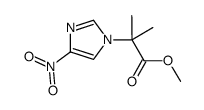| Description |
Nirogacestat (PF-3084014) is a reversible, noncompetitive, and selective γ-secretase inhibitor with IC50 of 6.2 nM.
|
| Related Catalog |
|
| Target |
IC50: 6.2 nM (γ-secretase)[1]
|
| In Vitro |
The IC50 of Nirogacestat (PF-03084014) for γ-secretase enzyme inhibition in cell-free assay for Aβ production using detergent solubilized membranes derived from HeLa cells is determined to be 6.2 nM. When tested for inhibition of Notch receptor cleavage in cellular assays using HPB-ALL cells that harbor mutations in both the heterodimerization and PEST domains in Notch1, the cell IC50 is determined to be 13.3 nM. Nirogacestat (PF-03084014) causes a significant increase in caspase-3 activities in HPB-ALL and TALL-1 cells as well as an induction of cleaved PARP and cleaved caspase-3 after a 7-day treatment[1].
|
| In Vivo |
Nirogacestat (PF-03084014) shows robust antitumor activity in this model on 14-day twice daily dosing. Tumor growth inhibition is dose dependent, with maximal tumor growth inhibition of ~92% obtained at high dose levels (150 mg/kg). In tumor growth inhibition studies where mice receive repetitive twice daily dosing for more than a week, Nirogacestat (PF-03084014) is well tolerated at dose levels below 100 mg/kg as no significant weight loss, morbidity, or mortality is observed. When the dose is increased to 150 mg/kg, however, mice have diarrhea and show weight loss (10-15%) approximately 10 days after compound administration. The body weight of treated animals usually returns to normal if dosing holidays are given, suggesting that the toxicity of Nirogacestat (PF-03084014) is reversible[1]. In the 7-day repeat dose toxicokinetic (TK) and first 1-month combination repeat dose studies, treatment with Dexamethasone alone and Dexamethasone with Nirogacestat (PF-03084014) cause moderate to marked body weight loss (-10% to -27%) after 7 days treatment. In the second 1-month combination repeat dose study, a similar magnitude of body weight loss (-10% to 22%) occurs with repeat dosing on the first week or third week of treatment with 100 mg/kg Nirogacestat (PF-03084014) and 1 mg/kg Dexamethasone. When Dexamethasone is not coadministered with Nirogacestat (PF-03084014) on the second week of study, increases (4%) in body weight are noted, suggesting that the body weight loss is reversible[2].
|
| Cell Assay |
Cells are seeded in 96-well plates at 2,000 (Sup-T1, Jurkat, and DND-41) or 10,000 (HPB-ALL or TALL-1) cells/well in growth media supplemented with 10% fetal bovine serum. Serial dilutions of Nirogacestat (PF-03084014) are done in DMSO, appropriate controls or designated concentrations of Nirogacestat (PF-03084014) are added to each well, and cells are incubated at 37°C for 7 days (final DMSO content 0.1%). Resazurin at a final concentration of 0.1 mg/mL is added to the cells and plates are incubated for 2 to 4 hours. Fluorescent signals are read as emission at 590 nm after excitation at 560 nm. IC50 values are calculated by using the sigmoidal dose-response (variable slope) in GraphPad Prism[1].
|
| Animal Admin |
Mice[1] Athymic female mice (nu/nu, 6-8 weeks) are used. For antitumor efficacy, animals bearing tumors of 150 to 300 mm3 in size are randomly divided into groups that received either vehicle (0.5% methylcellulose) or Nirogacestat (PF-03084014) (150 mg/kg, diluted in vehicle), and dosed by oral gavage. Animal body weight and tumor measurements are obtained every 2 to 3 days. Tumor volume (mm3) is measured with Vernier calipers and calculated. Percent (%) inhibition values are measured on the final day of study for drug-treated compared with vehicle-treated mice and are calculated. For all tumor growth inhibition experiments, 8 to 10 mice per dose group are used. Student's t test is used to determine the P value. Rats[2] Sprague-Dawley (SD) rats are useds. In the 7-day repeat dose TK study, 3 male rats per group are orally dosed with either 0.5% methylcellulose vehicle, Nirogacestat (PF-03084014) at 150 mg/kg/day, Nirogacestat (PF-03084014) at 150 mg/kg/day coadministered with 1 of the oral Dexamethasone doses (0.25, 1.0, 2.5, or 5.0 mg/kg/day) or Dexamethasone at 5 mg/kg/day and euthanized at 24 hr after the last dosing. The blood collection time points for determining Nirogacestat (PF-03084014) or Dexamethasone mean systemic plasma concentrations are 1, 2, 4, 7, and 24 hr post dosing. Test article-related findings are determined by assessing changes in clinical signs, pre- and post-dose body weights. Blood samples for assessing systemic exposure of Nirogacestat (PF-03084014) and Dexamethasone are collected from all treatment groups at various times on days 1 and 7 of the study. Blood samples for hematology evaluation are also collected from all the animals at 24 hr after the last dosing. The mean group changes in hematology parameters for treated rats are expressed as a percentage change. Necropsy is performed 24 hr after the last dose, body weights are recorded, and tissues are collected and submitted for histopathologic examinations.
|
| References |
[1]. Wei P, et al. Evaluation of selective gamma-secretase inhibitor PF-03084014 for its antitumor efficacy and gastrointestinal safety to guide optimal clinical trial design. Mol Cancer Ther. 2010 Jun;9(6):1618-28. [2]. Aguirre SA, et al. Intermittent oral coadministration of a gamma secretase inhibitor with dexamethasone mitigates intestinal goblet cell hyperplasia in rats. Toxicol Pathol. 2014;42(2):422-34.
|



